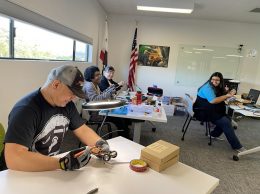AppFolio, MindBody must become profitable

Philip Joens
AppFolio and MindBody went through growing pains in 2015, spending more money than they earned. Now, 2016 needs to be the year of profitability.
On one hand, AppFolio and MindBody successfully transitioned from promising young startups into growing young companies in 2015. As we head into 2016, though, both companies have yet to answer how and when they will finally turn profitable.
AppFolio and MindBody both went public in June to great fanfare.
San Luis Obispo-based MindBody, which develops software and provides merchant processing for yoga studios and fitness clubs, raised $101 million when its stock sold for $14 per share on June 18. Goleta-based AppFolio, which makes property management software for small- to medium-sized real estate managers, held its initial public offering a week later on June 26 when 6.2 million shares sold for $12 each.
AppFolio said it intended to use capital from the IPO for marketing purposes, product research and development and to grow the company even more. MindBody said it planned to use the proceeds for working capital, operating expenses and to grow.
Heading into their IPOs, though, both companies had long histories of losing money. MindBody’s losses of $16.2 million in 2013 and $24.2 million in 2014 were far greater than AppFolio’s losses of $7.3 million and $8.6 million during the same years.
Both companies posted losses in their first quarters as public companies in the second quarter but analysts remained bullish.
“At some point their infrastructure is built, their operating expenses will flatten out relative to revenue growth,” Rick Tico, vice president at Bank of the West in Santa Barbara, said at the time.
Analysts were generally upbeat on both companies’ earnings calls. Some congratulated MindBody CEO Rick Stollmeyer on a great quarter. AppFolio CEO Brian Donahoo is a charismatic leader and offered soothing words to analysts on its call.
Analysts understandably started to get squirrely on third quarter earnings calls for both companies. AppFolio’s net losses more than tripled during the quarter from $1.27 million in 2014 to $4.76 million in 2015.
AppFolio Chief Financial Officer Ida Kane sounded coarse and seemed to rub some analysts the wrong way on this call, declining to answer questions giving forward financial guidance for the company.
That left analysts like William Blair’s Bhavan Suri nagging Kane at the end of the call for more financial guidance.
“Any change to your view on when you might achieve profitability or break even?” Suri asked during AppFolio’s third quarter earnings call.
Kane declined, only issuing a vague statement saying AppFolio is “continuing to invest in the business behind the success we’ve had thus far.”
MindBody’s historic trends of high revenues and higher operating costs continued. Net losses increased from $7.74 million to $9.63 million during the quarter. Revenues increased from $17.62 million during last year’s third quarter to $26.08 million. Operating expenses increased almost as fast, though, from $17.1 million last year to $25.66 million.
Stollmeyer defended the quarter on the call by saying revenues continue to grow, subscribers continue to grow, and the company brand continues to grow around the world.
“We achieved record net subscriber growth ending the quarter with 48,650 subscribers,” Stollmeyer said during the third quarter earnings call. “These effects, combined with the natural (Software as a Service) economies of scale, produce a business that can simultaneously grow and generate substantial cash in the future.”
MindBody is burning through investors’ cash with the thinking it will finally turn a profit in 2018 or slightly sooner.
Sources I’ve talked to in the tech industry like Tico think this is normal. Despite months of trying to understand this concept, I can’t wrap my brain around it.
As of Sept. 30, MindBody had lost $26.34 million in 2015. That’s up from losses of $18.1 million during the first three quarters of 2014. MindBody recently constructed an impressive headquarters building in San Luis Obispo, complete with cork floors, a wall of plants that scrub the air and even a slide between floors that developers use to get to meetings.
I’m no genius, but that way of running a business seems unsustainable.
MindBody currently has about 50,000 business subscribers in 140 countries. The company also wants to engage consumers using a new version of the MindBody app released Dec. 17.
Perhaps the most crucial piece of MindBody’s growth strategy is its integrated payment platform, which facilitates sales between businesses and consumers. Payments from that service increased 46 percent during the third quarter to $9.5 million and were 37 percent of MindBody’s revenue during the quarter.
AppFolio is also growing. It acquired San Diego startup RentLinx in April. AppFolio will also lease an additional 7,855 square feet of space at its office in Goleta, increasing the amount of space AppFolio leases to 26,490 square feet.
While it’s clear both companies are positioned well, the question of profitability still hangs in the air. Now, six months into their lives as public companies, the real work has begun.
Editor’s note: Entities affiliated with Investment Group of Santa Barbara, which owns a large stake in AppFolio, have a minority investment in the parent company of Pacific Coast Business Times.
• Contact Philip Joens at pjoens@pacbiztimes.com










